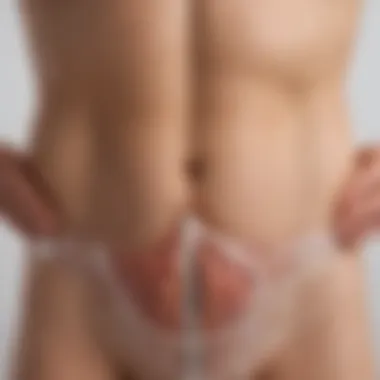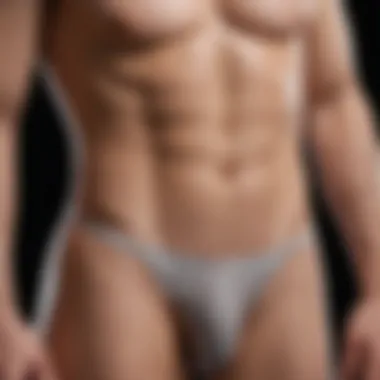Top Abdominal Binders for Managing Orthostatic Hypotension


Intro
Orthostatic hypotension, a condition often overlooked, can significantly impact daily life. For many individuals, the sudden drop in blood pressure upon standing can lead to dizziness, fainting, and in some cases, debilitating fatigue. This condition can disrupt the most mundane tasks, affecting productivity and overall quality of life. A practical approach to managing this condition involves the use of abdominal binders, which provide support and stability when navigating the challenges of blood pressure fluctuations.
Abdominal binders are specially designed to compress the abdomen, enhancing venous return and helping to stabilize blood pressure during sudden positional changes. These devices serve as a preventative measure against the uncomfortable symptoms of orthostatic hypotension. However, not all binders are created equal. Making an informed choice requires a careful examination of various products and their unique features, as well as consideration of personal needs.
In the sections ahead, we will delve into what constitutes an effective abdominal binder for managing orthostatic hypotension. We will explore how these binders work, the crucial selection criteria, and highlight top recommendations based on user feedback and clinical insights. This comprehensive guide aims to equip readers with the knowledge to make prudent health decisions.
Understanding Orthostatic Hypotension
Orthostatic hypotension, a condition familiar to many yet often underestimated, deserves our attention for several compelling reasons. It manifests when an individual stands up, thereby leading to a sudden drop in blood pressure. This can result in dizziness, fainting, or, in some cases, more severe complications. Grasping the nuances of orthostatic hypotension is critical not only for those who live with it but also for caregivers and health professionals who strive to manage it effectively.
The significance of this understanding lies in its direct link to quality of life. For many patients, the fear of sudden drops in blood pressure can significantly alter daily routines. Knowing how this condition works — particularly how and why it occurs — enables patients to take proactive steps in managing it, likely reducing anxiety and improving overall well-being. Armed with knowledge, one can avoid situations that might provoke symptoms and advocate for effective treatments, such as abdominal binders, that alleviate discomfort.
Defining Orthostatic Hypotension
To put it succinctly, orthostatic hypotension involves a significant drop in blood pressure when moving from a supine or sitting position to standing. This is not merely a momentary blip; it can present a whole array of symptoms that impede daily functions. The medical community describes this condition as a drop of 20 mmHg in systolic pressure or 10 mmHg in diastolic pressure after standing.
Imagine standing up too quickly after a prolonged period sitting–that feeling of light-headedness is a common precursor to orthostatic hypotension. It's characterized by a temporary imbalance in the body’s mechanism to regulate blood pressure. In healthy individuals, when standing, blood vessels constrict to maintain blood flow to vital organs. In those with orthostatic hypotension, this system falters, causing a rapid decrease in blood volume to the brain and other organs, leading to symptoms mentioned earlier.
Causes and Risk Factors
Understanding what triggers orthostatic hypotension is integral for both prevention and treatment. Among the myriad causes, dehydration is one of the most prevalent – insufficient fluid intake leads to reduced blood volume, making it harder for the body to stabilize blood pressure upon standing. Other culprits include prolonged bed rest or immobility, which can weaken the body’s natural mechanisms for adjusting blood pressure.
Risk factors abound, including:
- Age: As one grows older, the likelihood of experiencing orthostatic hypotension increases due to bodily changes.
- Medications: Diuretics, antidepressants, and certain heart medications can heighten risk by affecting blood volume or pressure regulation.
- Medical conditions: Diabetes and Parkinson’s disease can compromise nerve function which plays a role in blood pressure maintenance.
- Alcohol use: Excessive consumption can lead to dehydration, contributing to blood pressure drops.
Symptoms and Diagnosis
The symptoms of orthostatic hypotension range from mild to severe. Common experiences include lightheadedness, blurred vision, weak or rapid pulse, and, in extreme cases, fainting. When diagnosing this condition, healthcare providers often perform a simple but effective test: measuring blood pressure readings while sitting and standing. A notable dip in blood pressure during this transition strongly indicates orthostatic hypotension.
It’s crucial to note that these symptoms should not be taken lightly. Persistent cases warrant further investigation to rule out any underlying conditions.
In summary, comprehending orthostatic hypotension opens the door to effective management. By identifying causes, recognizing symptoms, and understanding the risk factors involved, individuals can empower themselves. Armed with this knowledge, they can pursue suitable supports like abdominal binders, designed to enhance stability and overall health in the face of this condition.
The Role of Abdominal Binders
Abdominal binders serve a critical function for individuals grappling with orthostatic hypotension. This condition, marked by abrupt drops in blood pressure upon standing or changing posture, can lead to dizziness and discomfort. Abdominal binders are more than mere garments; they’re a vital tool in managing symptoms and providing stability during daily activities. The emphasis on understanding their role lies in appreciating how these binders can fundamentally enhance quality of life.
How Abdominal Binders Work
Abdominal binders primarily function by providing support to the abdominal area. This support works through several mechanisms:
- Increased Intra-abdominal Pressure: The binders gently compress the abdomen, raising intra-abdominal pressure. This elevation can lead to improved venous return to the heart, thereby boosting blood circulation.
- Postural Stability: With their supportive nature, abdominal binders can aid individuals in maintaining better posture. Good posture helps in conserving energy and lessening the strain on the cardiovascular system when standing or moving.
- Enhanced Support During Movement: When a person with orthostatic hypotension stands up or shifts positions, their body needs to react quickly to regulate blood pressure. Binders help the body adapt by providing external support. In practical terms, this means a reduced feeling of light-headedness during sudden movements.
Overall, abdominal binders function as a supportive measure, assisting the body in maintaining blood flow during postural changes.
Benefits for Patients
The advantages of using abdominal binders extend beyond mere physical support. Individuals with orthostatic hypotension often face challenges in daily life, and these binders can bring several benefits, including:


"Abdominal binders can significantly minimize symptoms of orthostatic hypotension, providing patients with the ability to engage more fully in their lives."
- Symptom Management: Many patients report that wearing an abdominal binder helps reduce the severity of symptoms associated with sudden blood pressure drops. This can enhance overall comfort and promote more confident movement.
- Increased Daily Functionality: With better symptom control, individuals may find it easier to participate in daily tasks—be it walking the dog or running errands.
- Mental Well-Being: The psychological benefit of feeling more stable cannot be overlooked. Less fear of unexpected dizziness can lead to an improved mood and reduced anxiety in social situations.
- Complementary to Other Treatments: Abdominal binders often act synergistically with medications or therapeutic interventions for managing orthostatic hypotension, creating a comprehensive approach towards symptom relief.
In summary, abdominal binders play an essential role in the management of orthostatic hypotension, offering tangible relief and improvements in quality of life for those affected by this condition.
Key Features of Effective Abdominal Binders
When selecting an abdominal binder for managing orthostatic hypotension, it’s crucial to focus on specific features that enhance both comfort and function. An effective binder is more than just a piece of fabric wrapped around your abdomen; it's a vital tool that influences your response to blood pressure fluctuations. Key features such as material, adjustability, and durability can significantly impact the user experience and the effectiveness of the binder. Understanding these aspects helps in making an informed choice.
Material and Comfort
Choosing the right material for an abdominal binder cannot be overstated. The fabric should be breathable yet firm enough to offer adequate support. Common materials include cotton blends, neoprene, and elastic fabrics. Each material brings its own benefits:
- Cotton Blends: These are soft and gentle against the skin while allowing airflow, minimizing sweat and discomfort during prolonged use.
- Neoprene: Often used for its ability to retain heat, this may help with circulation but can cause overheating if worn too long.
- Elastic Fabrics: Designed for flexibility and stretch, this fabric can provide the necessary compression without feeling restrictive.
Comfort is not only about the fabric but also about how the binder shapes to your body. A well-designed binder can contour to the waist without causing pinching or rolling, maintaining a comfortable fit throughout the day.
"Comfort in a binder is key; if it feels like a vice, it won't be used as intended."
Adjustability and Fit
Next, let’s delve into adjustability and fit, which are pivotal in ensuring that the binder meets individual needs. Most effective binders offer adjustable straps or Velcro closures. This feature allows customization for a secure fit that accommodates changes in body posture from sitting to standing.
When looking at adjustability, consider:
- Multiple Sizes: Many brands provide a range of sizes to cater to different body types. A size that is too small can constrict blood flow, while one that's too large may not provide the needed support.
- Layered Design: Some binders come with a layered structure that allows users to increase or decrease compression based on their comfort level.
A snug fit, however, should not translate to discomfort. A good binder can stay in place without the wearer constantly readjusting it, contributing to peace of mind during daily activities.
Durability and Maintenance
Finally, durability and maintenance are essential factors to consider when investing in an abdominal binder. You want a product that can withstand daily wear and tear, especially if it’s intended for long-term use. Materials should hold their shape and elasticity after repeated washes.
For those who prioritize maintenance ease:
- Machine Washable: Look for binders that can be tossed into the washing machine. This can save time and effort, keeping hygiene in check.
- Colorfastness: Ensuring that colors do not bleed during washes can extend the life of the binder and keep it looking fresh.
Investing in quality will save money in the long run—cheap binders might seem appealing initially but often wear out faster, making them a poor choice for continuous use.
Understanding these key features lets you make a smart selection that can help mitigate symptoms of orthostatic hypotension effectively.
Top Binders on the Market
Selecting the right abdominal binder is crucial for managing orthostatic hypotension effectively. A well-designed binder can help enhance blood flow, provide essential support to the abdomen, and ease symptoms associated with rapid postural changes. In this section, we will dive into the specifics of popular models currently available, taking into account various elements like comfort, adjustability, and user satisfaction. The goal is to equip you with a thorough understanding of your options, so you can make the best choice for your needs.
Comparison of Popular Models
When trying to find the perfect abdominal binder, understanding how different models stack up against each other can save time and prevent frustration. Here are some popular options that are often recommended:
- Truform 1951 Abdominal Support
Known for its breathable material and moderate support, this model is especially favored for daily wear by those with chronic issues. Its adjustable design makes it user-friendly for various body types. - Neo G Medical Abdominal Support
This binder provides targeted compression, which can be beneficial for maintaining blood flow. Users appreciate its simple Velcro system that allows for a bespoke fit. - MediChoice Abdominal Binder
With a wide range of sizes, MediChoice tends to accommodate virtually everyone. The soft, elastic material enhances comfort while still being sturdy enough to provide solid support.


These models exemplify what is available on the market today. When choosing one, consider factors such as your body's specific needs, the severity of your condition, and personal comfort preferences.
User Reviews and Testimonials
Reading user experiences can provide valuable insights that may not be immediately obvious from product descriptions. Here’s a sampling of feedback from individuals who have used these abdominal binders for managing orthostatic hypotension:
- Many report feeling an immediate difference in stability after wearing binders, especially those engaging in work or activities that require prolonged standing.
- Some users noted that while certain models offer great support, they may also cause skin irritation if worn for extended periods. It’s often advised to take breaks or use a cover layer between your skin and the binder.
- A number of testimonials highlight satisfaction with variety in sizing, allowing users to find a fit that works for their unique body shapes.
Overall, testimonials underscore the importance of finding a model that not only provides support but is also comfortable enough for prolonged wear.
Expert Recommendations
Consulting experts can provide another layer of assurance in your selection process. Many healthcare providers emphasize the following when recommending abdominal binders:
- Comfort is key. An abdominal binder should feel snug but not overly tight. Experts frequently note that excessive pressure can lead to additional issues.
- Look for versatility. Binders that can be adjusted easily allow for more tailored support, which is essential as your needs may change over time.
- Quality matters. Higher-quality materials may cost more upfront but often prove to be more cost-effective over time due to their durability.
"Choosing the right abdominal binder can significantly impact your quality of life. Always prioritize personal comfort along with the expected benefits of support."
How to Properly Use an Abdominal Binder
Understanding how to properly use an abdominal binder is critical when managing orthostatic hypotension. These devices can play a significant role in stabilizing blood flow and supporting your abdomen during sudden shifts in posture. A correct approach to using these binders can maximize their benefits, lessen discomfort, and ensure that you get the most value out of the product. Here, we delve into the nuances of fitting, daily wear, and the vital aspect of monitoring effectiveness.
Initial Examination and Fitting
Before even looking at the binder itself, it’s imperative to begin with an examination that guides you on how best to utilize these devices. The first step should be a thorough assessment by a healthcare professional who can determine the right type of binder suited for your specific needs. This examination allows for the identification of underlying health conditions that may require tailored support.
After the examination, fitting becomes exceptionally vital. An abdominal binder should fit snugly but not so tight that it restricts movement or breathing. A poor fit might lead to discomfort or diminish the binder's effectiveness. A good rule of thumb: you should be able to slide two fingers underneath the binder without feeling excessive pressure.
Daily Use Tips
Now that you’ve got the right binder fitting well, let's talk about daily use. For optimal results, integrating the binder into your daily routine is essential. Here are some practical tips:
- Wear During Critical Times: Many patients find it helpful to wear their abdominal binder during activities that typically lead to symptoms, like standing for long periods or physical exertion.
- Not Just for Standing: While binders are often associated with standing, wearing it while sitting or lying down can also offer support during those positions, especially during transitions.
- Layering Clothes: Consider wearing it underneath your clothing. This not only maintains a discreet appearance but also provides consistent support throughout the day.
- Hydration: Keeping well-hydrated complements the binder’s function. Good fluid intake may also help reduce the symptoms of orthostatic hypotension.
Monitoring Effectiveness
Monitoring the effectiveness of your abdominal binder isn’t just about checking if it feels comfortable or if you're experiencing fewer symptoms. It’s about a holistic approach to your health management. Here’s how to do it:
- Regular Check-Ins: Schedule time—perhaps weekly—to assess if the binder still fits well and functions effectively. Have your symptoms improved? Are you finding any discomfort?
- Documet Symptoms: Keep a log of how your symptoms change in correlation with your binder usage. This can be an eye-opener when discussing treatment options with healthcare providers.
- Assess Activity Levels: Note if you can engage in daily activities with less fatigue or dizziness when wearing the binder. A positive change indicates that it's serving its purpose well.
"Proper use of an abdominal binder can transform your experience with orthostatic hypotension, making daily life much more manageable."
Taking these precautions into account when using an abdominal binder not only fosters a supportive environment for those managing orthostatic hypotension but also aids in improving overall quality of life. The key lies in understanding one’s body and adapting the use of the binder accordingly—making it a reliable ally in navigating daily challenges.
Potential Drawbacks and Limitations
Despite the clear benefits of abdominal binders for individuals dealing with orthostatic hypotension, it’s essential to address certain drawbacks and limitations that come with their usage. Not every solution fits every issue, and understanding these potential problems can help users make better-informed decisions about their health management.
Discomfort and Skin Issues
Abdominal binders are designed to provide support and compression, but they can also cause discomfort, especially during prolonged use. Some patients might experience skin irritations or rashes due to the binder’s materials. Common issues include chafing, pressure marks, or allergic reactions to synthetic fabrics. Users often describe a feeling akin to being squeezed too tightly, which can be distracting and detract from their overall comfort.


To mitigate these discomforts, consider the following actions:
- Choose breathable materials: Some binders are made from specialized fabrics that promote airflow and moisture-wicking, reducing the risk of irritation. Look for options listed as hypoallergenic.
- Adjust fit regularly: A well-fitted binder shouldn't cause constant pressure. Make adjustments when putting it on and throughout the day to ensure comfort.
- Limit wear time: Try not to rely on the binder for an entire day. Shorter periods of use can help reduce skin issues and discomfort.
Ultimately, finding the right abdominal binder is paramount. Testing different styles or brands can assist in identifying what works best for your body.
Overreliance on Support
One concern that arises with the regular use of abdominal binders is the possibility of developing an overreliance on external support. While these binders do provide essential help by stabilizing blood pressure and alleviating symptoms, it may lead users to avoid engaging in other critical aspects of their health management.
For some individuals, wearing a binder may encourage a sedentary lifestyle. The custom of depending solely on the binder might overshadow the necessity of other essential strategies such as:
- Regular physical activity: Engaging in light exercises can strengthen core muscles, which can often help stabilize blood pressure naturally rather than solely relying on a binder.
- Diet adjustments: Nutritional changes, including increasing salt intake under medical guidance, can also stabilize blood pressure without needing to depend exclusively on a binder.
- Monitoring hydration: Staying well-hydrated supports healthy blood volume and pressure levels, providing additional support beyond what the binder offers.
Avoiding these supportive measures could lead to complications or minimal improvement over time. In essence, while it is tempting to lean heavily on the comfort of an abdominal binder, it should complement, not replace, a holistic management plan aimed at addressing orthostatic hypotension comprehensively.
"A comprehensive approach is paramount; combining binders with lifestyle adjustments can yield the best results."
Being mindful of these limitations ensures that while abdominal binders play a valuable role, they are part of a broader strategy for health management.
Alternatives to Abdominal Binders
Exploring alternatives to abdominal binders is essential for those managing orthostatic hypotension. While binders can provide substantial support, they aren’t the only option out there. Some individuals may find that other devices or lifestyle changes can also help alleviate their symptoms. It’s worth considering these alternatives, as they may offer the flexibility to tailor a management plan that suits individual needs better.
Other Supportive Devices
Several supportive devices can serve as substitutes or complements to abdominal binders. These options often focus on providing stability or pressure in various ways, which can be pivotal when dealing with blood pressure fluctuations.
- Compression Garments: These can be effective, particularly those designed to compress the lower limbs. They help enhance venous return, thereby minimizing the impact of blood pooling in the vessels when standing too quickly.
- Orthotic Devices: Foot orthotics or specialized shoes can improve stability and balance. By ensuring proper foot positioning, they can contribute indirectly by fostering a more stable posture and reducing strain on the cardiovascular system during sudden movements.
- Tilt Table or Recliner Chairs: An adjustable recliner or a tilt table can provide varying degrees of support and comfort during the transition between sitting and standing. They help individuals gradually acclimate, reducing that dizzy sensation that can accompany sudden changes in posture.
Each of these alternatives has individual benefits and considerations that might suit different lifestyles or preferences. The key is to assess each option carefully, discussing it with healthcare professionals for personal recommendations.
Exercise and Lifestyle Modifications
Incorporating exercise and lifestyle modifications can significantly impact the management of orthostatic hypotension. Regular physical activity strengthens the body, improves circulation, and can enhance overall cardiovascular health.
To include exercise effectively in daily routines:
- Walking: Simple but effective. Regular walks can help the body adapt to changes in position, reinforcing the muscles that support circulation.
- Strength Training: Engaging in resistance exercises strengthens abdominal and leg muscles, which can help in maintaining blood pressure levels during postural changes. Incorporating activities such as squats and leg raises can be beneficial.
- Hydration: Staying hydrated can help maintain blood volume, lessening the risk of hypotension. It’s a straightforward but crucial lifestyle change.
- Dietary Adjustments: Consuming smaller, more frequent meals can alleviate the dips in blood pressure often felt after larger meals. Additionally, increasing salt intake—if approved by a healthcare provider—may help retain fluid and boost blood volume.
Exercise and lifestyle changes go hand-in-hand. As exertion increases, so does the body’s ability to handle the effects of orthostatic hypotension. Keeping a focus on consistency makes all the difference.
In summary, a combination of supportive devices and adjustments in daily living can present refreshing alternatives to abdominal binders, offering patients a more comprehensive approach to managing their symptoms.
Epilogues and Final Thoughts
The discussions surrounding abdominal binders and their role in managing orthostatic hypotension have illuminated their potential benefits and limitations. In examining this topic, it becomes clear that such devices are more than just simple fabric straps. Rather, they serve a specific purpose, offering a tangible solution to a condition that can significantly affect day-to-day life.
The importance of selecting the right binder cannot be overstated. Factors like material, comfort, adjustability, and durability play crucial roles in ensuring that users not only find relief but do so without experiencing side effects. We urge readers to take a careful look at these features when considering their options, as proper fit can make all the difference.
Moreover, the benefits of these binders extend beyond just physical support. They provide psychological reassurance, making individuals feel more secure in their mobility. This can encourage a more active lifestyle, temporarily alleviating the challenges posed by orthostatic hypotension. However, it is equally critical to recognize the limitations of reliance on such devices. Overuse may lead to dependency, which can compromise the body's natural response mechanisms.
"In the world of health, balance is key. Binders can support, but knowledge and awareness empower."
As we conclude, it’s vital to stress the importance of continual assessment—of both the device and one’s condition. Integrating binders into treatment should not overshadow the role of lifestyle modifications, physical therapy, or potential medication adjustments. Therefore, an open line of communication with healthcare professionals remains paramount.
Ultimately, finding the best abdominal binder is a matter of combining personal experience with professional guidance, ensuring that the individual health journey is both informed and proactive.







